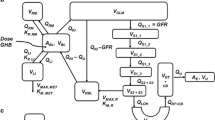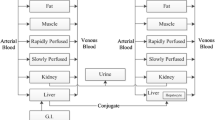Abstract
A physiologically based pharmacokinetic model, which is an extension of the Bischoff-Dedrick multiorgan model, was developed to describe the kinetics of barbiturates (hexobarbital, phenobarbital, and thiopental) in the rat. The model is composed of 11 organ or tissue compartments. The brain compartment was featured as a nonflow-limited organ for some low lipid soluble barbiturates. Michaelis-Menten constants for drug metabolism (Km, Vmax were determined from in vitroexperiments using liver microsomes. Binding of drugs to plasma and tissue proteins was measured in vitrousing an equilibrium dialysis method. Distribution of drugs to red blood cells was measured in vitrowith thiopental exhibiting a concentration dependent distribution. Penetration rates of the barbiturates into the brain were predicted on the basis of their lipid solubilities. A set of mass balance equations included terms for the inflow and outflow of drug carried by the perfusing blood, drug metabolism, protein binding, and penetration rate into the brain as well as blood flow rate and tissue mass. Solution of the system of equations yielded the time courses of drugs in each organ. However, predicted time courses of drugs in plasma and brain were not in good agreement with those observed. Therefore, the tissue to plasma distribution ratios evaluated from in vivoexperiments were substituted for the in vitrovalues, resulting in fairly good agreement between predicted and observed values.
Similar content being viewed by others
References
R. L. Dedrick and K. B. Bischoff. Pharmacokinetics in application of the artificial kidney.Chem. Eng. Prog. Symp. Ser. 64:32–44 (1968).
H. S. G. Chen and J. F. Gross. Physiologically based pharmacokinetic models for anticancer drugs (general review).Cancer Chemother. Pharmacol. 2:85–94 (1979).
K. J. Himmelstein and R. J. Lutz. A review of the applications of physiologically based pharmacokinetic modeling.J. Pharmacokin. Biopharm. 7:127–145 (1979).
J. H. Lin, M. Hayashi, S. Awazu, and M. Hanano. Correlation betweenin vitro andin vivo drug metabolism rate: oxidation of ethoxybenzamide in rat.J. Pharmacokin. Biopharm. 6:327–337 (1978).
L. S. Goodman and A. Gilman.The Pharmacological Basis of Therapeutics, 5th ed., Macmillan, New York, 1975, pp. 105–123.
S. Mayer, R. P. Maickel, and B. B. Brodie. Kinetics of drugs and other foreign compounds into cerebrospinal fluid and brain.J. Pharmacol. Exp. Ther. 127:205–211 (1959).
B. B. Brodie, H. Kurz, and L. S. Schanker. The importance of dissociation constant and lipid solubility in influencing the passage of drugs into the cerebrospinal fluid.J. Pharmacol. Exp. Ther. 130:20–25 (1960).
O. H. Lowry, N. J. Rosebrough, A. L. Farr and R. J. Randall. Protein measurement with Folin phenol reagent.J. Biol. Chem. 193:265–275 (1951).
T. Omura and R. Sato. The carbon monooxide binding pigment of liver microsomes.J. Biol. Chem. 239:2370–2378 (1964).
Y. Sugiyama, T. Iga, S. Awazu, and M. Hanano. Multiplicity of sulfobromophthalein-binding proteins in Y-fraction from rat liver.J. Pharmacobiol. Dyn. 2:193–204 (1979).
Y. J. Lin, S. Awazu, M. Hanano, and H. Nogami. Pharmacokinetic aspects of elimination from plasma and distribution to brain and liver of barbiturates in rat.Chem. Pharm. Bull. 21:2749–2756 (1973).
H. S. G. Chen and J. F. Gross. Estimation of tissue-to-plasma partition coefficients used in physiological pharmacokinetic models.J. Phamacokin. Biopharm. 7:117–125 (1979).
J. S. McCarthy and R. E. Stitzel. Kinetic differences in the microsomal metabolism of the isomers of hexobarbital.J. Pharmacol. Exp. Ther. 176:772–778 (1971).
B. B. Brodie, L. C. Mark, E. M. Papper, P. A. Lief, E. Bernstein, and E. A. Rovenstein. The fate of thiopental in man and a method for its estimation in biological material.J. Pharmacol. Exp. Ther. 98:85–96 (1950).
T. Nakagawa and Y. Koyanagi. SALS, a computer program for statistical analysis with least squares fitting. Library program of the University of Tokyo Computer Center, Tokyo, Japan (1978).
J. H. Lin, Y. Sugiyama, S. Awazu, and M. Hanano. Kinetic studies of the deethylation of ethoxybenzamide.Biochem. Pharmacol. 29:2825–2830 (1980).
J. G. Jolly, C. Doyon, and Y. Pesant. Cytochrome P-450 measurement in rat liver homogenate and microsomes.Drug. Metab. Disp. 3:577–586 (1975).
H. Greim. Synthesesteigerung und Abbauhemmung bei der Vermehrung der mikrosomalen Cytochrome P-450 und b-5 durch Phenobarbital.Naunyn-Schmiedebergs Arch. Pharmak. 266:261–275 (1970).
B. Shoene, R. A. Fleischman, and H. Remmer. Determination of drug metabolising enzymes in needle biopsies of human liver.Eur. J. Clin. Pharmacol. 4:65–73 (1972).
D. L. Cinti and J. B. Schenhman. Hepatic organelle interaction I: Spectral investigation during drug biotransformation.Mol. Pharmacol. 8:327–338 (1972).
T. Matsubara, M. Koike, A. Tauchi, Y. Tochino and K. Sugeno. Quantitative determination of Cytochrome P-450 in rat liver homogenate.Anal. Biochem. 75:596–603 (1976).
M. Hananoet al. Library Program (D2/TC/RKM) of the University of Tokyo Computer Center (1978).
L. C. Mark. Metabolism of barbiturates in man.Clin. Pharmacol. Ther. 4:504–530 (1963).
L. R. Goldbaum and P. K. Smith. The interaction of barbiturates with serum albumin and its possible relation to their disposition and pharmacological actions.J. Pharmacol. Exp. Ther. 111:197–209 (1954).
D. Shen and M. Gibaldi. Critical evaluation of use of effective protein fraction in developing pharmacokinetic models or drug distribution.J. Pharm. Sci. 63:1698–1703 (1974).
N. Filous, B. Fichtl, and H. Kurz. Binding of drugs to muscle tissue.NaunynSchmiedebergs Arch. Pharmacol. 293(Suppl.):R46 (1976).
L. S. Shanker and A. S. Morrison. Physiological disposition of guanethidine in the rat and its uptake by heart slices.Int. J. Neuropharmacol. 4:27–39 (1965).
T. M. Ludden, L. S. Schanker, and R. C. Lanman. Binding of organic compounds to rat liver and lung.Drug Metab. Dispos. 4:8–16 (1976).
G. Wahlström. Increased penetration of barbital through the blood-brain-barrier in the rat after pretreatment with probenecid.Acta Pharmacol. Toxicol. 43:260–265 (1978).
G. H. Evans, A. S. Neis, and D. G. Shand. The disposition of propranolol III: Decreased half-life and volume of distribution as a result of plasma binding in man, monkey, dog, and rat.J. Pharmacol. Exp. Ther. 186:114–122 (1973).
K. B. Bischoff, R. L. Dedrick, D. S. Zaharko, and J. A. Longstreth. Methotrexate pharmacokinetics.J. Pharm. Sci. 60:1128–1133 (1971).
N. Benowitz, R. P. Forsyth, K. L. Melmon, and M. Rowland. Lidocaine disposition kinetics in monkey and man I: Prediction by a perfusion model.Clin. Pharm. Ther. 16:87–98 (1974).
Y. Sasaki and N. Wagner. Measurement of the distribution of cardiac output in unanesthetized rats.J. Appl. Physiol. 30:879–884 (1968).
R. L. Dedrick, D. S. Zaharko, and R. J. Lutz. Transport and binding of methotrexatein vivo.J. Pharm. Sci. 62:882–890 (1973).
R. J. Lutz, R. L. Dedrick, H. B. Matthews, T. E. Eling, and M. W. Anderson. A preliminary pharmacokinetic model for several chlorinated biphenyls in the rat.Drug. Metab. Dispos. 5:386–396 (1977).
Author information
Authors and Affiliations
Rights and permissions
About this article
Cite this article
Igari, Y., Sugiyama, Y., Awazu, S. et al. Comparative physiologically based pharmacokinetics of hexobarbital, phenobarbital, and thiopental in the rat. Journal of Pharmacokinetics and Biopharmaceutics 10, 53–75 (1982). https://doi.org/10.1007/BF01059183
Received:
Revised:
Published:
Issue Date:
DOI: https://doi.org/10.1007/BF01059183




